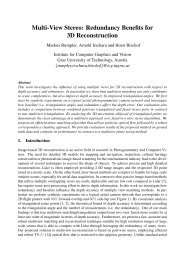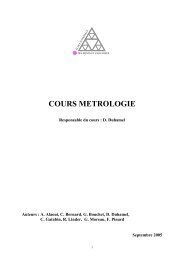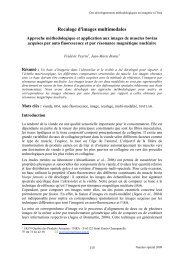Least-squares fitting of carrier phase distribution by using a rational ...
Least-squares fitting of carrier phase distribution by using a rational ...
Least-squares fitting of carrier phase distribution by using a rational ...
You also want an ePaper? Increase the reach of your titles
YUMPU automatically turns print PDFs into web optimized ePapers that Google loves.
December 15, 2006 / Vol. 31, No. 24 / OPTICS LETTERS 3589<br />
through the angles , , and (which are basic system<br />
parameters for determining the orientation <strong>of</strong><br />
the camera in 3D space), respectively, the coordinates<br />
<strong>of</strong> E in OXYZ can be calculated with<br />
x E<br />
y<br />
E <br />
cos sin 0<br />
1<br />
cos 0 − sin <br />
<br />
E = − sin cos 0 0 1 0<br />
z 0 0 sin 0 cos <br />
1 0 0 E <br />
0 cos sin y E <br />
2<br />
0 − sin cos x 0.<br />
The line CE crosses R at D. By utilizing the equation<br />
<strong>of</strong> CE, i.e., x−x C /x E −x C =y−y C /y E −y C =z<br />
−z C /z E −z C , the equation <strong>of</strong> R, i.e., z=0, and Eq. (2),<br />
the coordinates <strong>of</strong> D, x D ,y D ,z D , are calculated with<br />
x D<br />
y<br />
D x Cz E − x E z C /z E − z C <br />
<br />
D = y C z E − y E z C /z E − z C <br />
z 0<br />
1 x E + b 2 y E /1+a 1 x E + a 2 y E <br />
=b<br />
b 3 x E + b 4 y E /1+a 1 x E + a 2 y E , 3<br />
0<br />
where a 1 =−sin /z C , a 2 =sin cos /z C , b 1 =cos <br />
cos −x C sin /z C , b 2 =cos sin +sin sin cos <br />
+x C sin cos /z C , b 3 =−cos sin −y C sin /z C , and<br />
b 4 = cos cos − sin sin sin + y C sin cos /z C .<br />
Because D and E produce their images at the same<br />
pixel, the <strong>carrier</strong> <strong>phase</strong> at i,j equals the reference<br />
<strong>phase</strong> at D. That is,<br />
i,j = D .<br />
Figure 1(b) shows the relationship between the<br />
projector and R, where P is the center <strong>of</strong> the projector<br />
lens. The fictitious plane G passes through O and is<br />
perpendicular to the optical axis <strong>of</strong> the projector lens.<br />
Therefore the fringes projected on G are kept parallel<br />
to each other and are equally spaced with pitch p.<br />
The XOY plane <strong>of</strong> the system OXYZ is superposed<br />
on G, and the Y axis is parallel to the fringes.<br />
Assuming that OXYZ can be transformed to<br />
OXYZ <strong>by</strong> rotations around the X, Y, and Z axes<br />
in sequence, through the angles , , and , respectively,<br />
and that the coordinates <strong>of</strong> P in OXYZ are<br />
x P ,y P ,z P , the coordinates <strong>of</strong> D in OXYZ can be<br />
calculated with<br />
x D <br />
= 1 0 0<br />
<br />
cos 0 sin<br />
<br />
<br />
y D 0 cos − sin 0 1 0<br />
z D<br />
0 sin cos − sin 0 cos<br />
<br />
cos − sin 0<br />
1 x 0<br />
D<br />
sin cos 0 y D .<br />
5<br />
0 0<br />
4<br />
PD crosses G at F. By <strong>using</strong> the equation for PD, i.e.,<br />
x−x P / x D −x P =y−y P /y D −y P = z−z P /z D −z P ,<br />
the equation for G, i.e., z=0, and Eq. (5), the coordinates<br />
<strong>of</strong> F are obtained with<br />
x F P z D − x D z P /z D − z P <br />
y F y P z D − y D z P /z D − z P <br />
z F =x<br />
<br />
0<br />
= d 1x D + d 2 y D /1+c 1 x D + c 2 y D <br />
<br />
d 3 x D + d 4 y D /1+c 1 x D + c 2 y D , 6<br />
0<br />
where c 1 = cos sin cos − sin sin / z P , c 2<br />
=−cos sin sin +sin cos /z P , d 1 =cos cos +x P <br />
cos sin cos −sin sin /z P , d 2 =−cos sin −x P <br />
cos sin sin +sin cos /z P , d 3 =sin sin cos <br />
+cos sin +y P cos sin cos −sin sin /z P , and<br />
d 4 = −sin sin sin + cos cos − y P cos sin sin <br />
+sin cos /z P . Noting that DF is an equal-<strong>phase</strong><br />
line, we have<br />
D = F = O +2x F /p,<br />
7<br />
where O is the <strong>phase</strong> at O. Utilizing Eqs. (1), (3), (4),<br />
(6), and (7) yields<br />
i,j = r + si + tj/1+ui + vj,<br />
where u=a 1 + c 1 b 1 + c 2 b 3 /1 − a 1 + c 1 b 1 + c 2 b 3 i o<br />
− a 2 +c 1 b 2 + c 2 b 4 j o , v = a 2 + c 1 b 2 + c 2 b 4 /1<br />
−a 1 + c 1 b 1 + c 2 b 3 i o − a 2 + c 1 b 2 + c 2 b 4 j o , r = 0<br />
−2 d 1 b 1 + d 2 b 3 i o +d 2 b 4 +d 1 b 2 j o /p1−a 1 +c 1 b 1<br />
+c 2 b 3 i o −a 2 +c 1 b 2 +c 2 b 4 j o , s= 0 a 1 +c 1 b 1 +c 2 b 3 <br />
+2d 1 b 1 + d 2 b 3 /p/ 1 − a 1 + c 1 b 1 + c 2 b 3 i o − a 2<br />
+ c 1 b 2 + c 2 b 4 j o t = 0 a 2 + c 1 b 2 +c 2 b 4 +2 d 2 b 4<br />
+ d 1 b 2 /p/ 1− a 1 + c 1 b 1 +c 2 b 3 i o −a 2 +c 1 b 2 +c 2 b 4 <br />
j o . Differing from the existing methods, 5–8 Eq. (8)<br />
can exactly model the <strong>carrier</strong> <strong>phase</strong> map for an arbitrary<br />
system scheme.<br />
Derivation <strong>of</strong> Eq. (8) makes it possible in principle<br />
to determine the <strong>carrier</strong> <strong>phase</strong> <strong>distribution</strong> from the<br />
system parameters. However, the difficulty remains<br />
that these parameters are hard to know exactly. As<br />
an alternative approach, the coefficients <strong>of</strong> Eq. (8)<br />
can be estimated from the measured <strong>phase</strong> <strong>distribution</strong><br />
<strong>of</strong> a standard plane (i.e., reference plane). For<br />
simplifying the computation, we recast Eq. (8) in the<br />
following linear form,<br />
r + si + tj − ui,ji − vi,jj = i,j, 9<br />
8<br />
where the reference <strong>phase</strong> i,j has been measured.<br />
When i,j varies, a linear system based on Eq. (9) is<br />
established, from which r, s, t, u, and v can be solved.<br />
Using Eq. (9) involves a biased estimation, <strong>by</strong> which<br />
the expectations <strong>of</strong> the estimated coefficients in the<br />
presence <strong>of</strong> noise slightly deviate from their true values.<br />
Because the deviations are very small, the results<br />
are still satisfactory. If a higher accuracy is required,<br />
the nonlinear system based on Eq. (8) must<br />
be solved, and an iterative procedure has to be implemented.





